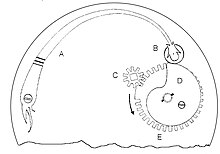Stackfreed
The Stackfreed , also misleadingly called spring brake , is a simpler mechanism that is able to compensate for the varying force of the mainspring of a watch by acting as a brake when the movement is fully wound and as a support when the spring force subsides. Because the more a tension spring is stretched, the greater the supplied from the drive wheel torque . The Stackfreed consists of a cam disc firmly connected to the drive wheel (called the stop wheel in the picture) and a leaf spring which presses on the outer edge of the cam disc with a roller. The torque compensation is optimal when the torque from the sum of the torques caused by the tension spring and the stack freed remains constant over the entire process, which can be achieved by an appropriate design of the cam disk and leaf spring.
Most cams are more or less helical or kidney-shaped. With the Stackfreed, two different mechanical effects act simultaneously, namely friction and torque influences. The friction between the leaf spring and the cam disk and in the bearing of the drive wheel reduces the torque, but the pressure of the leaf spring on the contour of the cam disk can both reduce and increase it (see function of the heart disk for zeroing the hands in chronographs). Theoretical considerations by Nuttall and practical tests by Pavel show that the torque generated by the Stackfreed is sufficient to achieve torque compensation. Accordingly, the function of the Stackfreed is less based on friction (spring brake) than on the torque generated by the Stackfreed.
The Stackfreed was mainly used in southern Germany from approx. 1510 to approx. 1650, after the invention of the “better” chain / screw balancing mechanism . The reason for this was that the Stackfreed was easier to construct, easier to repair, and allowed the construction of thinner clocks.
The origin and meaning of the name Stackfreed are unclear. In the Encyclopédie by Diderot and d'Alembert ( Encyclopédie ou Dictionnaire raisonné des sciences, des arts et des métiers ) the Stackfreed mechanism is described under the name “stochfred”.
further reading
- Heinrich Pavel: Comments on the Stackfreed. In: Annual journal of the German Chronometry Society. Volume 42, 2003, pp. 65-85.
- Hugh Tait: The Stackfreed. With technical descriptions by PG Coole, revised by David Thompson. (= Cat. Of Watches in the British Museum. 1). London 1987.
Web links
- Stackfreed in British Museum
- Stackfreed Pocket Watch
Individual evidence
- ^ JE Nuttall, How did the Stackfreed really work? Horological Journal, May 1997
- ↑ H. Pavel, Notes on the Stackfreed in: Deutsche Gesellschaft für Chronometrie, annual publication 2003, volume 42
